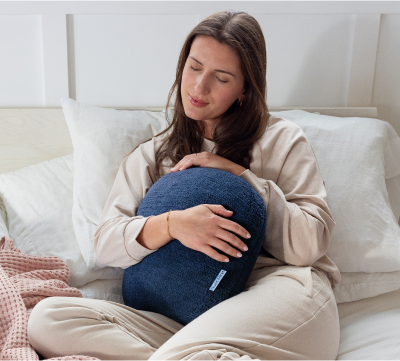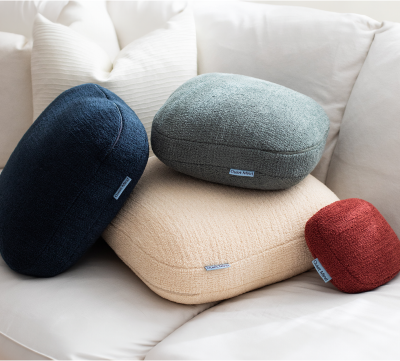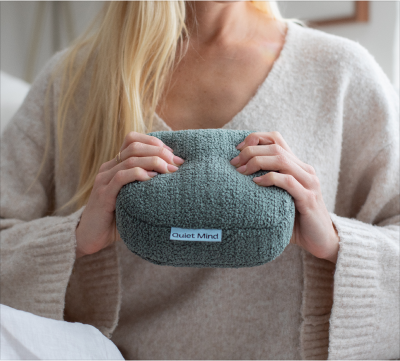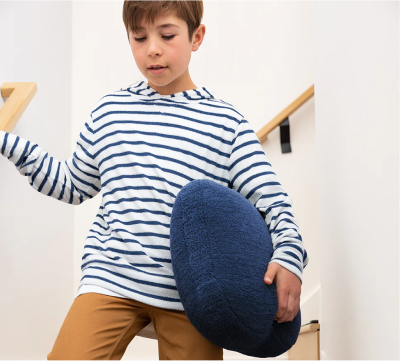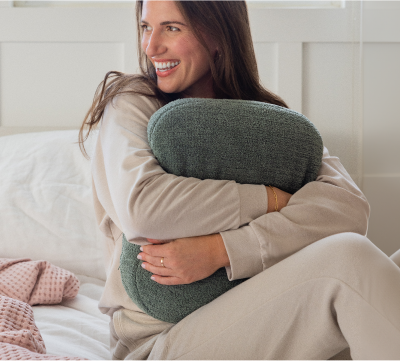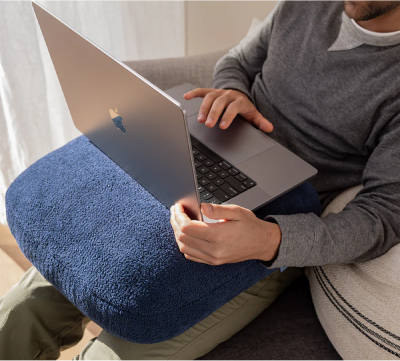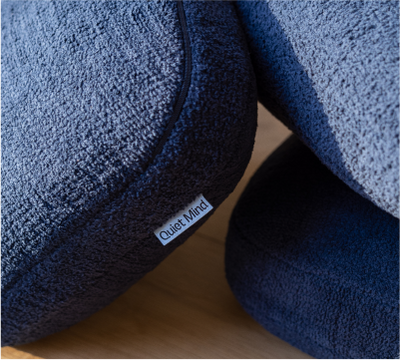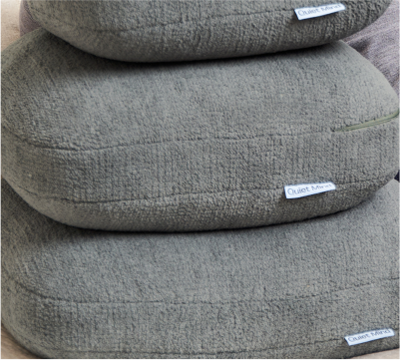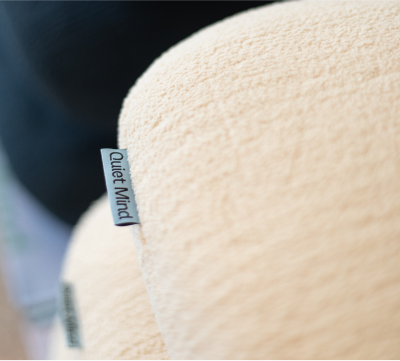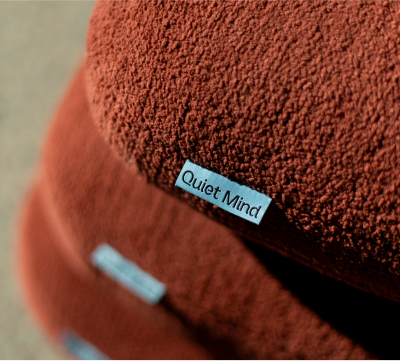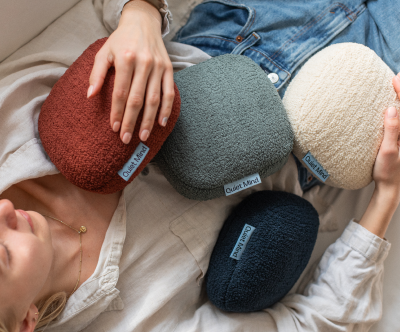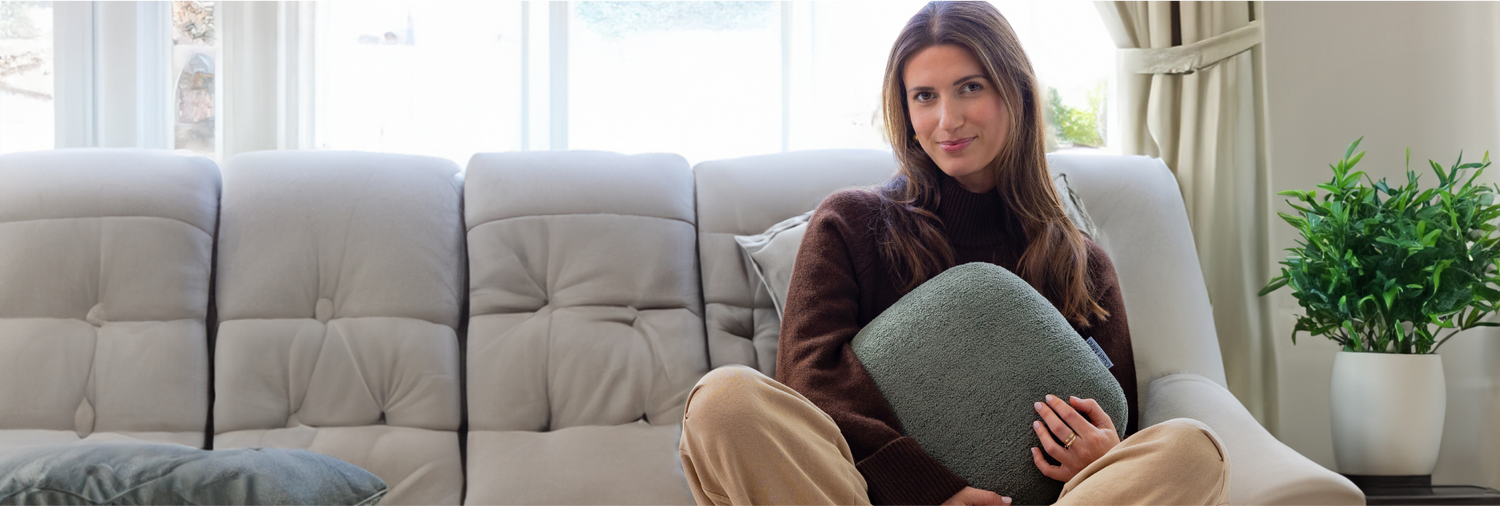Weighted blankets offer more than just warmth—they provide a sense of calm, stillness, and grounding that many people find soothing for sleep or sensory regulation. But what gives them that comforting weight? Inside each blanket is a thoughtful combination of fillers, fabrics, and stitching designed to deliver gentle pressure in just the right way.
Understanding these inner components can help you choose a blanket that truly supports your body and your nervous system.
What Makes a Blanket Weighted?
A weighted blanket might look like any cozy throw from the outside, but inside, it’s thoughtfully designed to provide a sense of calm and groundedness. Unlike standard blankets, weighted versions contain evenly distributed fillers that add gentle pressure across the body.
This pressure mimics a therapeutic technique known as deep touch pressure—a form of tactile input shown to help regulate the nervous system.
These blankets are typically built in layers:
- An outer fabric layer that touches your skin.
- One or more internal layers of soft padding.
- A filler layer that gives the blanket its weight.
- Reinforced stitching to hold everything together.
This layered approach ensures that the blanket doesn’t just feel heavy—it feels supportive, secure, and soothing.
Inner Materials That Add Weight
The comforting weight of a weighted blanket comes from tiny fillers stitched into quilted pockets throughout the fabric. These fillers are selected for their density, texture, and ability to stay in place without clumping. Their job is to create a gentle, even pressure that helps calm the body and support relaxation.
Common filler types include glass beads, plastic pellets, steel shot beads, and natural materials like sand or rice. Each creates a distinct sensory experience—some are better suited for warm climates or summer use, while others feel smooth and quiet or have a slightly textured, more noticeable feel when the blanket moves.
Because the type of filler can change how the blanket feels, sounds, and performs, it’s important to understand their differences. In the next section, we’ll explore each option to help you find the one that matches your sensory preferences and sleep needs.
Common Weighted Blanket Fillings Explained
Weighted blanket fillers each have their own texture, weight, and sound profile. Choosing the right one depends on how you respond to touch, movement, and sensory pressure. Some materials feel smoother and quieter, while others offer more texture or density depending on how they’re layered.
Many high-quality weighted products—like Quiet Mind’s Original Weighted Pillow—combine recycled glass beads for weight with soft polyurethane foam for cushioning. This pairing helps deliver even pressure without clumping, along with a supportive yet gentle feel that’s easy to relax into.
Glass Beads
Glass beads are tiny, smooth, and almost sand-like in texture. Because of their small size and weight, they distribute pressure very evenly and move quietly within their stitched pockets.
This filler is often chosen for its refined, unobtrusive sensory feel, especially by people who are sensitive to sound or texture. When cushioned by a layer like soft foam—as seen in some thoughtfully designed products—the result is a stable, comforting pressure that doesn’t overwhelm.
Plastic Poly Pellets
Plastic pellets are larger and lighter than glass beads, which means more of them are needed to achieve the same weight. They can feel slightly bumpier to the touch, especially in lighter-weight products, and may create more noticeable movement or sound.
They’re commonly found in mid-range or entry-level blankets.
Steel Shot Beads
Steel shot beads are very dense, which allows for more weight in a smaller volume. This can make the blanket feel more compact and less bulky. However, steel beads can also feel firmer and may need extra padding to avoid sharpness against the body.
They tend to stay cooler, which some users find helpful in warmer climates or during summer use.
Natural Fillers (e.g., sand, rice, or grains)
Some homemade or short-term-use weighted blankets use natural fillers like sand or rice. While these materials can create a pleasant initial feel, they tend to absorb moisture, break down over time, and are not typically washable.
They may also trigger allergies or sensitivities in some individuals.
Whether you're drawn to the soft drape of glass beads or need the compact density of steel shot, the right filler is the one that matches your body, your environment, and your sensory needs. And when materials like beads are cushioned with supportive foam and encased in a breathable, durable fabric—as seen in well-constructed designs—they can provide a grounded, reassuring experience night after night.
Weighted Blanket Fabric Layers and Stitching
Beyond the weight itself, the outer fabric and stitching design shape the comfort and functionality of a weighted blanket. These layers influence breathability, texture, and how securely the inner materials stay in place during use or washing.
Outer Fabric Choices (Cotton, Bamboo, Minky)
The fabric that wraps around the inner layers plays a key role in how a weighted product feels against the skin and performs over time. Common outer fabrics include:
- Cotton: breathable and familiar, often preferred by warm sleepers.
- Bamboo: ultra-soft, cooling, and moisture-wicking—ideal for those sensitive to heat or texture.
- Minky: plush and textured, offering deep tactile comfort for those who enjoy a cozy, cocoon-like feel.
- Polyester: smooth, durable, and low-maintenance—commonly used in products designed for everyday use and repeated washing.
Quiet Mind’s Original Weighted Pillow uses a durable polyester outer layer, chosen for its ability to withstand regular handling while still feeling soft and grounding against the skin. For those who need consistent sensory support without the upkeep of more delicate fabrics, polyester offers a balanced solution—both long-lasting and easy to care for.
Choosing the right fabric depends on your sensory needs, sleep habits, and lifestyle. Some people prioritize texture, while others focus on temperature or washability. A well-made outer layer should feel soothing, not distracting—and hold up through use without compromising comfort.
Quilted Pockets for Weight Distribution
To keep the weight evenly spread, weighted blankets are stitched into grid-like pockets. This stitching serves several purposes:
- Prevents fillers from shifting or bunching
- Ensures consistent pressure across the body
- Enhances durability and washability
A well-stitched weighted blanket will not only last longer but will also feel more balanced, especially for those who rely on stable sensory input to relax.
Are Weighted Blankets Safe and Comfortable Inside?
It’s natural to wonder whether weighted blankets might feel too warm or cause irritation—especially if you’re a warm sleeper or have sensitive skin. Fortunately, many modern weighted products are thoughtfully designed to stay breathable and gentle, making them suitable for a wide range of comfort needs.
Breathability and Cooling Options
A weighted blanket or pillow should feel grounding—not stifling. One of the most common concerns is overheating, particularly for those who experience temperature sensitivity or anxiety-related night sweats.
Breathability often depends on the combination of filler and fabric:
- Glass beads tend to retain less heat than plastic or natural fillers.
- Outer layers made from cotton or bamboo can increase airflow and moisture control.
- Some products incorporate cooling gels or moisture-wicking materials for added relief in warmer climates.
Quiet Mind’s Original Weighted Pillow is filled with recycled glass beads, which are known for staying cool and dispersing heat more evenly than other materials. The polyester outer cover, while not classified as a cooling fabric, is smooth and low-friction, helping reduce trapped warmth when used in short sessions or layered over breathable bedding.
If you’re especially heat-sensitive, choosing a product with low-heat retention fillers and lightweight outer materials can make a noticeable difference in comfort.
Safe and Gentle Materials
For people with allergies, skin sensitivities, or respiratory conditions, it’s important to choose materials that feel safe as well as soothing. While not all weighted blankets are labeled hypoallergenic, many use non-toxic, skin-friendly materials that avoid common irritants.
Quiet Mind’s design emphasizes simplicity and safety:
- Recycled glass beads offer a clean, odorless filling without plasticizers
- Polyurethane foam adds cushioning without harsh textures or chemical smells
- Removable outer cover allows for easy cleaning and regular use
You want to ensure that what’s inside the blanket is just as safe and gentle as what’s on the outside. If you have respiratory issues, skin sensitivities, or mobility concerns, it's worth taking the time to understand who can safely use a weighted blanket—and who might need to avoid them.
A safe weighted blanket is one you can trust to support your well-being every night—not something you need to worry about.
How the Inside of a Weighted Blanket Affects Sleep
The internal design of a weighted blanket isn't just about heaviness—it directly influences how your body and nervous system respond. From pressure distribution to tactile feedback, these materials play a vital role in supporting sleep and emotional regulation.
Deep Touch Pressure and Sensory Feedback
At the heart of every weighted blanket is the principle of Deep Touch Pressure (DTP), a calming, firm-but-gentle sensation that signals the brain to slow down and feel safe. Exploring the broader effects of weighted blankets can help make sense of these responses.
This kind of touch has been shown to:
- Increase serotonin and dopamine, both of which support emotional balance
- Reduce cortisol, the stress hormone
- Help regulate the nervous system for better focus, calm, and sleep
For people with ADHD, anxiety, or sensory processing challenges, DTP feels like a secure hug—without the emotional complexity of human interaction. The materials inside the blanket determine how well this pressure is delivered: uniform, soft pressure = soothing sensory feedback.
Weight Distribution and Its Role in Anxiety Relief
Consistent, even pressure is essential—not just for comfort, but also for emotional regulation. Poorly made blankets may shift their weight or bunch up, leading to a disruptive sensory experience rather than a calming one.
The inner structure affects:
- Whether the blanket hugs you or slides off
- If certain areas feel too heavy or too light
- Whether movement at night wakes you up or soothes you back to sleep
When fillers stay put in quilted pockets, your body gets a stable cue: “you’re safe, stay grounded.” This is especially beneficial during restless nights or periods of emotional dysregulation.
Comparing the Inside of Cheap vs High-Quality Weighted Blankets
Not all weighted blankets are built the same. The quality of fillers, stitching, and construction can dramatically affect how well a blanket performs, how long it lasts, and whether it truly feels supportive or distracting over time.
Durability and Stitching Quality
High-quality blankets don’t just look nicer—they’re built to last longer, perform better, and feel safer.
Key differences:
|
Feature |
Cheap Blanket |
High-Quality Blanket |
|
Stitching |
Sparse or weak; may leak fillers |
Dense, reinforced grid with tight seams |
|
Filler Movement |
Fillers shift, causing uneven weight |
Fillers stay in place for consistent pressure |
|
Lifespan |
6 months–1 year |
3–5+ years with regular use |
|
Washability |
May degrade quickly |
Often machine washable or come with removable covers |
A well-stitched blanket provides reliability—something that’s incredibly valuable when you're using it to manage sensory overload or support sleep.
Types of Fillers Used in Premium Blankets
Not all fillers are created equal. Premium blankets tend to use:
- Micro glass beads for smoother, quieter weight
- Steel beads for compact, heavier options
- Certified plastic pellets that are odorless and BPA-free
Cheap blankets may use:
- Bulkier plastic that’s harder to distribute
- Mixed filler types without clear labeling
- Fillers that create noise, clumping, or uneven feel
The internal material you choose can make or break how a weighted blanket supports your sleep, anxiety, or sensory needs. Blankets that feel too heavy or too light can interrupt the calming effect—especially if they fall outside your ideal weight-to-body comfort range.
How to Choose a Weighted Blanket Based on Inner Materials
Choosing a weighted blanket involves more than just picking a weight. The texture, temperature response, and sound of the filler should all align with your unique sensory preferences and comfort needs.
Weight-to-Body Ratio Guidelines
A simple rule: choose a blanket that’s approximately 10% of your body weight. Adjust slightly depending on your preference for lighter or deeper pressure.
|
Body Weight (lbs) |
Recommended Blanket Weight (lbs) |
|
40–70 (children) |
4–7 |
|
100–120 |
10–12 |
|
121–150 |
12–15 |
|
151–180 |
15–18 |
|
181–200 |
18–20 |
|
201+ |
20+ |
This isn’t a strict rule. Some people—particularly those with ADHD or anxiety—may find slightly heavier pressure more grounding. Others, especially those with sensory sensitivities, may prefer a lighter option.
If you’re choosing a blanket for a child or someone with a health condition, it’s always a good idea to consult a healthcare provider first.
Sensory Sensitivities and Material Preferences
The feel of a weighted product matters just as much as its weight—especially for those with sensory processing differences. Whether you're drawn to deep pressure or easily overstimulated by certain textures or sounds, the right combination of materials can make a noticeable difference in comfort. Quiet Mind’s Original Weighted Pillow is designed with this in mind: recycled glass beads for quiet, even pressure, polyurethane foam for gentle cushioning, and a smooth polyester cover that’s soft but not overstimulating.
Here’s how those materials align with common sensory needs:
- Tactile sensitivities: The polyester surface offers a clean, neutral texture.
- Heat sensitivity: Glass beads retain less heat than plastic or bulky fillers.
- Sound sensitivity: Glass is quieter and smoother than plastic pellets.
- Chemical sensitivity: No harsh dyes or plasticizers, keeping materials simple and clean.
The right weighted product doesn’t just feel heavy, but also your sensory preferences, sleep habits, and comfort level—making the decision more personal than formulaic.
Final Thoughts: What’s Inside Shapes the Experience
Weighted blankets aren’t just about the outer softness—they're about what lies beneath. The inner structure, fillers, and stitching determine not just comfort but how well the blanket supports sensory regulation, anxiety relief, and restful sleep.
Choosing the right one is a deeply personal decision. Take time to consider:
- Your sensory preferences
- How much weight feels calming
- Whether you need cooling, hypoallergenic, or quiet materials
At QuietMind, we believe every detail—inside and out—should support your journey toward calm, clarity, and deeper rest.
About Quiet Mind
At Quiet Mind, we believe in the power of simple, natural solutions to ease the mind and body. Our signature weighted pillows are designed to provide comforting pressure, helping to alleviate stress, anxiety, and restlessness.
Whether you're seeking a moment of calm during a hectic day or a more restful night's sleep, Quiet Mind offers tools to support your journey toward tranquility. Discover the soothing embrace of our weighted pillows and find your path to a quieter mind.
FAQs About What’s Inside Weighted Blankets
Are the fillers noisy or uncomfortable?
That depends on the type. Glass beads and micro steel beads are usually quiet and smooth. Plastic pellets may make a faint rustling sound, especially in lighter blankets or if the stitching is sparse. Quality blankets minimize this with internal padding or tight quilting.
Do weighted blankets contain toxic materials?
Reputable weighted blanket brands use non-toxic, lead-free, and BPA-free materials. Look for certifications such as:
- OEKO-TEX® for fabric safety.
- BPA-free plastic if used.
- Lead-free labeling on beads or pellets.
If a blanket doesn’t clearly state these standards, it may be better to avoid it—especially for children or people with allergies.
Can the inner beads leak out over time?
Yes, but only if the stitching fails or the fabric is poor quality. Blankets with reinforced grid stitching and double-lined pockets are far less likely to leak. Avoid washing weighted blankets too often unless they’re designed for it—this can weaken seams over time.
What’s the difference between glass and plastic beads?
Glass beads are smaller, heavier, and smoother—offering quiet, even weight distribution and a more refined feel. Plastic beads are larger, lighter, and may feel slightly textured or noisy. They’re more common in budget-friendly blankets and can shift more easily.
Is one type of filling better for hot sleepers?
Yes. Glass beads and steel beads are better for hot sleepers because they retain less heat and are used in blankets with breathable outer fabrics like bamboo or cotton. Avoid minky or fleece fabrics if you’re prone to overheating.
